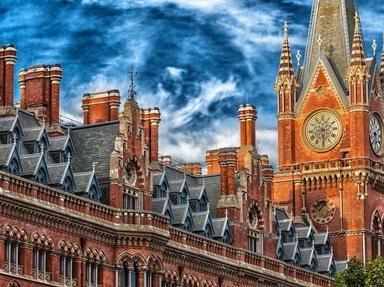Quiz Answer Key and Fun Facts
1. A is for ARSENAL, one of London's leading football clubs. Today the club is associated with the Highbury area of North London, where they have played their home games since 1913. But where did the club originally come from?
2. B is for BILLINGSGATE, a wholesale market. What is bought and sold at Billingsgate?
3. C is for the CAFÉ ROYAL. In the past this was the meeting-place of literary men and artists like Oscar Wilde, Frank Harris, James Whistler, Max Beerbohm, Augustus John and Walter Sickert. In which street would you have found it?
4. D is for DENMARK STREET, a short street running off Charing Cross Road. With what activity is this street associated?
5. E is for EALING, a western suburb of London. In the late 1940s and early 1950s the film studios at Ealing were famous for producing what kind of films?
6. F is for FLEET STREET, one of the main thoroughfares of the ancient City of London. With which industry or profession was it traditionally associated?
7. G is for the GREAT FIRE OF LONDON. In which year did this occur?
8. H is for HAMPTON COURT, a palace on the banks of the Thames about fifteen miles south-west of central London. For whom was Hampton Court originally built?
9. I is for ISLINGTON. This district of London once had a famous coaching inn, whose name survives as the name of the nearby underground railway station. The name will also be familiar to anyone who has played Monopoly on a British board. What was the inn called?
10. J is for JACK STRAW'S CASTLE. What is or was this building?
11. K is for KENSINGTON GARDENS, west of Hyde Park. Which children's book character is commemorated by a statue in the Gardens?
12. L is for LONDON BRIDGE. The present bridge was opened in 1972. The previous bridge can now be seen in the United States - in which state?
13. M is for the MANSION HOUSE. Whose official residence is this?
14. N is for NATIONAL GALLERY, one of Britain's and the world's leading art galleries. Where will you find it?
15. O is for OXFORD STREET. Oxford Street is probably London's busiest shopping street, but many of London's most famous shops are located elsewhere. Which of these four is the only shop located in Oxford Street?
16. P is for PICCADILLY CIRCUS. At this famous roundabout you can see a statue which was intended to represent the Angel of Christian Charity. But by what name is it generally known?
17. Q is for QUEEN'S PARK RANGERS. Who are they?
18. R is for RITZ. The Ritz Hotel is at 150 Piccadilly. What was the nationality of César Ritz, after whom it is named?
19. S is for STATUES. London is full of statues. Some of the people commemorated by them are virtually unknown to Londoners in the twenty-first century, but some of them are still well known and affectionately remembered. Whose statue stands on top of a 145-foot column in Trafalgar Square?
20. T is for the TOWER OF LONDON. Which of the following was NOT executed at or very close to the Tower?
21. U is for the UNIVERSITY BOAT RACE between crews from Oxford and Cambridge, rowed on the Thames every year during the universities' Easter vacation. How long, approximately, is the course?
22. Since I used up Victoria in my "UK Alphabeticals" quiz, V is for the VETERAN CAR RUN. This annual event sees veteran cars starting out from Hyde Park Corner in London to travel to which resort on the south coast?
23. W is for WHITECHAPEL in the East End of London. In 1888 Whitechapel was the scene of a series of unsolved murders of prostitutes, which have fascinated aficionados of crime ever since. By what nickname is the murderer generally known?
24. Y is for YEOMEN OF THE GUARD. For most people this term refers to the "Yeomen Extraordinary" or "Yeomen Warders" who act as custodians and guides at the Tower of London. Who wrote a light opera about them?
25. Z is for ZOO. The London Zoo is one of the earliest and best known zoological gardens in the world. Where is it?
Source: Author
TabbyTom
This quiz was reviewed by FunTrivia editor
ozzz2002 before going online.
Any errors found in FunTrivia content are routinely corrected through our feedback system.

